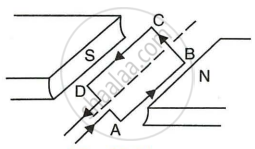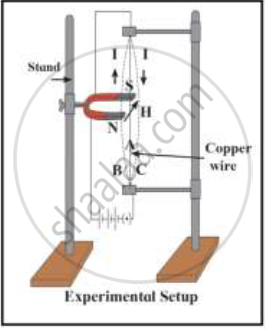Advertisements
Advertisements
प्रश्न
State the rule to determine the direction of a force experienced by a current-carrying straight conductor placed in a magnetic field which is perpendicular to it.
उत्तर
Fleming's Left-Hand Rule, also known as the Motor Rule, states that the thumb, first finger, and middle finger of the left hand should all be extended such that they are perpendicular to one another. The thumb indicates the direction of the conductor's motion (i.e., the direction of force acting on the conductor) if the first (fore) finger points in the direction of the magnetic field, the middle finger points in the direction of current, and so on.
APPEARS IN
संबंधित प्रश्न
State Fleming’s left-hand rule.
What concealed do you get from the observation that a current-carrying wire deflects a compass needle placed near it?
State qualitatively the effect of inserting an iron core into a current-carrying solenoid.
The magnetic field associated with a current-carrying straight conductor is in anticlockwise direction. If the conductor was held along the east-west direction, what will be the direction of current through it? Name and state the rule applied to determine the direction of current?
A current-carrying conductor is held in exactly vertical direction. In order to produce a clockwise magnetic field around the conductor, the current should passed in the conductor:
(a) from top towards bottom
(b) from left towards right
(c) from bottom towards top
(d) from right towards left
For Fleming's left-hand rule, write down the three things that are 90° to each other, and next to each one write down the finger or thumb that represents it.
A current-carrying conductor is placed perpendicularly in a magnetic field. Name the rule which can be used to find the direction of force acting on the conductor.
State Fleming's left-hand rule. Explain it with the help of labelled diagrams.
A coil ABCD mounted on an axle is placed between the poles N and S of a permanent magnet as shown in Figure.

- In which direction will the coil begin to rotate when current is passed through the coil in direction ABCD by connecting a battery at the ends A and D of the coil?
- Why is a commutator necessary for continuous rotation of the coil?
- Complete the diagram with commutator, etc. for the flow of current in the coil?
i) Which principle is explained in this figure?
ii) Which rule is used to find out the direction of a force in this principle?
iii) In which machine this principle is used? Draw a diagram showing working of that machine

State Fleming's left handle rule.
Differentiate between Conductors and insulators.
State whether a magnetic field is associated or not around a moving charge.
Write Fleming’s left hand rule.
The north pole of Earth’s magnet is in the ____________.
Assertion (A): A magnetic field exerts a force on a moving charge in the same direction as the direction of the field itself.
Reason (R): The direction of force is given by Fleming’s left-hand rule.
Which of the following pattern correctly describes the magnetic field around a long straight wire carrying current?
If the strength of the current flowing through a wire is increased, the strength of the magnetic field produced by it ______.
A copper conductor is placed over two stretched copper wires whose ends ate connected to a D.C. supply as shown in the diagram.
- What should be the magnetic poles at the points A and B lying on either side of the conductor to experience the force in the upward direction?
- Name the law used to find these polarities.

